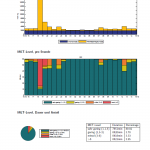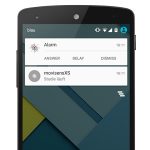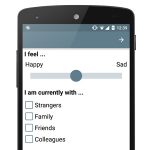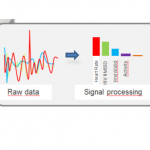Activity Monitoring
movisens provides researchers with access to some of the best tools for measuring physical activity in everyday life. Through our physiological sensors and/or smartphone-based experience sampling, movisens expertise helps researchers answer their activity related questions.
Recommendations for the following questions
Measurement of steps, activity classes, movement intensity and/or activity level
Accelerometers such as the Move 4 allow the continuous, objective recording of physical activity in everyday life. The acceleration data allows the calculation of parameters such as the number of steps, activity classes (such as sitting, walking, jogging), movement intensity and activity level. Using a barometric pressure sensor enables an expanded range of activity classifications. Thus the Move 4 distinguishes between normal walking and climbing stairs with accuracy unseen in our competitors.

Energy Expenditure estimation in everyday life
Using data gathered by the activity sensor Move 4, the DataAnalyzer uses a two-stage activity based algorithm to calculate the energy expenditure of a person in everyday life. The algorithm first analyses the signal to determine the activity class that’s occurring (e.g. sitting, walking, jogging, climbing stairs). After determining the appropriate activity model, both the energy expenditure and MET values are calculated from the acceleration data and participant’s personal data (age, height, weight). A inability to determine uphill/downhill, and upstairs/downstairs reveals why most activity sensors wildly under or overestimate Energy Expenditure. Movisens implemented a barometric air pressure sensor in order to allow a greater accuracy by distinguishing these activities.

Energy Expenditure estimation for sedentary activities
If you want to estimate the energy expenditure in situations where the person is sitting (such as cycling, strength training or rowing) movisens recommends the ECG and activity sensor EcgMove 4. During these activities a lot of energy expenditure occurs, without the body experiencing a lot of acceleration. The addition of the ECG signal allows researchers to observe periods of intense activity that may remain hidden if relying on the acceleration in isolation.

GPS-based activity monitoring
Whilst a dedicated physiological sensor provides the best detailed view of a person’s activity, smartphone’s can offer a broad level analysis of behaviour. The experience sampling platform movisensXS can determine the location of the user via GPS. The software records the user's GPS points using a battery-saving algorithm and creates and evaluates location profiles, e.g. to calculate a route.
With further functions movisensXS offers advanced solutions for activity monitoring in addition to the pure recording of GPS points. Setting a geofence around a particular set of GPS co-ordinates allows another element of behavioural analysis. If a participant enters a geofence, leaves it or remains within it for a certain time, a questionnaire can trigger and ascertain more information about their current activities.

Subjective recording of physical activity
Experience Sampling also enables researchers who measure physical activity to gain a subjective assessment of physical activity, including information such as the motivation for physical activity, or the state of health by the use of smartphone questionnaires. This real time assessment avoids the distortion that occurs with memory and the retrospective recall issues common with Daily Diary studies. Our class leading platform movisensXS allows a wide variety of sampling possibilities, in order to capture the data when it matters.

Joint recording of objective and subjective aspects of physical activity
A unique combination of sensors and smartphone allows researchers the opportunity to capture both qualitative subjective data, and quantitative objective data. This allows the continuous recording of objective physical data using our activity monitor Move 4, whilst simultaneously obtaining qualitative statements via questionnaires using the experience sampling platform movisensXS. An exclusive development by movisens allows the experience sampling platform to deliver questionnaires based on changes in activity levels detected by the physiological sensors.

Example studies
Paracelsus 10.000
Paracelsus 10.000, is a large investigation program to collect and analyze the health status of the population of Salzburg. It’s investigating the causes and relationships of metabolic, cardiac, pulmonary and neurodegenerative diseases in order to develop targeted preventive measures against stroke, heart attack, diabetes and other diseases. This project measures physical activity over an 8 day period using the Move II to determine the relationship between physical activity, metabolism, cardiovascular system and other biomarkers.
PEZ
The ZI (Zentralinstitut für Seelische Gesundheit) Mannheim conducts a pilot study "PEZ Study" on the effect of environmental factors on well-being and mental health. The PEZ study examines the relationships between environmental conditions, everyday stressors and personality traits in order to identify mechanisms that make people resistant or susceptible to mental illness over the long term. With the help of mobile devices, everyday movement patterns on satellite-supported maps are determined and combined with movisensXS smartphone questions to determine the state of mind in everyday life. Tissue sample analysis and imaging methods contribute to this large ambulatory assessment project.
Useful Information
Physical activity looms as a critical factor in tackling the current health problems, with sedentary behaviour posing a new challenge to health care systems around the world. Due to its relevance in prevention and health improvements, promoting the importance of physical activity within public health services remains a critical objective.
To accurately record the effects of physical activity in scientific studies, we need to select amongst the various methods of tracking such activity, each with its strengths and weaknesses.
Subjective survey methods such as questionnaires or diaries depend on too greatly on the memory of the study participants and remain susceptible to data bias. The validity of retrospectively collected self-reports concerning physical activity sadly provides a very low correlation to objective measurement methods.
A better objective measurement of physical activity is achieved with acceleration sensors (accelerometers) and heart rate monitors. The combination of heart rate measurement and accelerometry limits the measurement errors associated with a single procedure. For example, accelerometers do not detect elements such as emotional reactions. In contrast, heart rate monitors allow the detection of activity of movements such as cycling and swimming via the association with an increase in heart rate. The combined measurement allows a refined calculation of the energy expenditure in everyday situations.
Literature
Byrom, B., Stratton, G., McCarthy, M., & Muelhausen, W. (2016). Objective measurement of sedentary behaviour using accelerometers. Int. J. Obes, 40(Lond), pp. 1809-1812.
Anastasopoulou, P. Development of multiparametric activity monitoring in everyday life. Ph.D. dissertation,2014.
Anastasopoulou, P., Tubic, M., Schmidt, S., Neumann, R., Woll, A., and Härtel, S. Validation and Comparison of Two Methods to Assess Human Energy Expenditure during Free-Living Activities. PLoS ONE 9, 2, e90606, 2014.
Assah FK, Ekelund U, Brage S, Wright A, Mbanya JC, Wareham NJ (2011) Accuracy and validity of a combined heart rate and motion sensor for the measurement of free-living physical activity energy expenditure in adults in Cameroon. Int J Epidemiol, 40, 112-120.
Barreira TV, Kang M, Caputo JL, Farley RS, Renfrow MS (2009) Validation of the Actiheart Monitor for the Measurement of Physical Activity. Int J Exerc Sci, 2, 60-71. Brage S, Brage N, Franks PW, Ekelund U, Wareham NJ (2005) Reliability and validity of the combined heart rate and movement sensor Actiheart. Eur J Clin Nutr, 59, 561-570.
Byrom, B., Stratton, G., McCarthy, M., & Muelhausen, W. (2016). Objective measurement of sedentary behaviour using accelerometers. Int. J. Obes, 40(Lond), pp. 1809-1812.
Müller C, Winter C, Rosenbaum C (2010) Aktuelle objektive Messverfahren zur Erfassung körperlicher Aktivität im Vergleich zu subjektiven Erhebungsmethoden. Deutsche Zeitschrift für Sportmedizin, 61, 11-18.
Strath SJ, Bassett DR Jr., Swartz AM, Thompson DL (2001) Simultaneous heart rate-motion sensor technique to estimate energy expenditure. Med Sci Sports Exerc, 33, 2118-2123.
Strath SJ, Bassett DR, Jr., Thompson DL, Swartz AM (2002) Validity of the simultaneous heart rate-motion sensor technique for measuring energy expenditure. Med Sci Sports Exerc, 34, 888-894.
Welk GJ (2002) Physical Activity Assessment for Health-Related Research. Human Kinetcis, 1. Auflage
WHO (World Health Organization) (2010) Bewegung und Gesundheit in Europa: Erkenntnisse für das Handeln. Gesundheit Österreich GmbH Geschäftsbereich Fonds Gesundes Österreich.